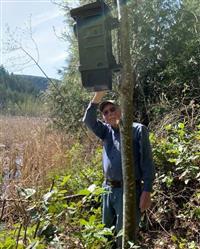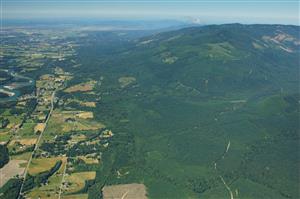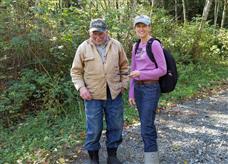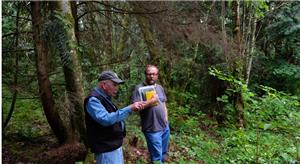“All of this used to be trees.” It’s a common statement many of us have said or heard as we have driven the I-5 corridor. The conversion of forestlands south of Skagit County has blurred the edges of cities and towns. The changing landscape affects a lot more than our view. Fortunately, some landowners are helping to keep our local forests intact through conservation.
 | | Jim Owens, who owns working forestlands south of Mount Vernon, is getting ready for spring. “The wood ducks are coming back and I’ve got some new nest boxes to install for them.” The nest boxes are part of an ongoing cycle of caring for the forest he has owned and managed for the past 25 years. Also on the task list is checking the wildlife cameras that he has stationed throughout his 40-acre property. “Someone said they saw cougars the other day,” Jim shares with excitement in his voice. “It’s about time for a bear to show up. That’s what I look for in the spring. Wood ducks and bear tracks.” |
 |  | |
Jim Owens is working with Skagit Land Trust to put a working forest conservation easement on his 40-acre property south of Mount Vernon. The project area is near Devil’s Mountain, the forested ridge between I-5 and Big Lake. Devil’s Mountain is a rarity in our region – a large block of mostly intact forest close to Puget Sound. This extensive forest serves many purposes including providing a habitat corridor for wildlife between Little Mountain Park, the Pilchuck Tree Farm, and DNR forestlands.
“A working forest ensures a place for these animals,” says Jim, who is an active member of the Washington Farm Forestry Association. “The ground is more likely to stay there if you can profit from a little logging from time to time. The conservation easement is a good start for that.”
 |  |
| Looking west, down the Skagit River Valley (Hwy 20) towards the Skagit/Samish Flats, one can see the distinct line between forest lands and development. | The county line between Snohomish and Skagit. Skagit County maintains a good deal of its working forest, but the pressure to develop these lands is strong. |
| |
Much of our once vast forestlands in western Skagit County have now been replaced with human activities. Skagit’s low elevation forests are called “Forests on the Edge”. These are forests that face risks from escalating housing development and infrastructure. You can see the creep on Blanchard Mountain and along the forested foothills near I-5, Hwy 20, and Hwy-9.
Forests in the Pacific Northwest and Skagit County are one of our most valuable resources. Yet over time as more of our forests “convert to development” there is increasing landscape fragmentation. This interrupts the vital role forests play in providing abundant water, wildlife habitat, recreational areas and mitigation for climate impacts. As forests fragment, they no longer provide forest-related jobs or products for the local mill. Water quality declines due to increased sediment in creeks, warming waters, and the impacts of septic systems, lawn and garden chemicals.
“There is a lot of talk in Skagit County about not losing our valuable farmland and for good reason,” says Skagit Land Trust’s Conservation Project Manager Kari Odden. “What about our forests? We know people have to live somewhere but are our foothills destined to be covered with houses, lawns, and roads?”
Thanks to the support of our members, partners, local landowners, and the Washington State Recreation and Conservation Office’s Forestland Preservation Program, Skagit Land Trust is working on an alternative vision. We see a county where the forests remain, with new development largely filling in our cities and designated growth areas. Diverse animal and plant life thrive, and water quality is protected. We retain recreational and economic benefits as well as conservation of our native forests and the local harvest of forest products on working forests.
 | |  |
| Jim Owen & Kari Odden on site tour |  | Jim and Mark HItchock discuss the forest health |
Small to very large forests can remain in private ownership and be conserved, forever. Skagit Land Trust works with interested landowners to help them place a conservation easement on their property. This legal tool permanently limits the amount of development or other uses on a piece of land. Some landowners want the conservation easement to help their forests to become old growth. Others prefer that their forest be available for wood products and timber harvest, along with the myriad of benefits that forests provide. Forest landowners can benefit from either selling or donating their development rights. Forests of all kinds are needed for our future.
“We need to ramp up tools like working-forest conservation easements not just to protect ecosystem services, but also the economic and community benefits that are produced from forests,” says Board Member and retired forestry consultant Mark Hitchcock.
So far, the Trust holds two working-forest conservation easements. The Owens conservation easement will be the third and will extinguish four development rights and protect wetlands and a creek. It will also ensure that the property continues to be available as a working forest under future ownership.
“Beaver, bear, bobcat, I’ve seen them all,” says Jim. “I liked the idea of the conservation easement keeping the area a forest more than a bunch of houses. That’s what it comes down to. There seems to be more development all of the time. My property is not enough space for a bear or a cougar, but being adjacent to DNR lands is why I see these animals come through the property.”
“Foresters don’t just grow trees, most also provide habitat for wildlife and maintain forest health,” says Odden. “Skagit Land Trust believes that more of this type of land conservation – including on very largescale working forests – can strengthen our local economy and provide healthy and functional natural areas that sustain our communities.”
 |
| The view from the top of the conservation easement |